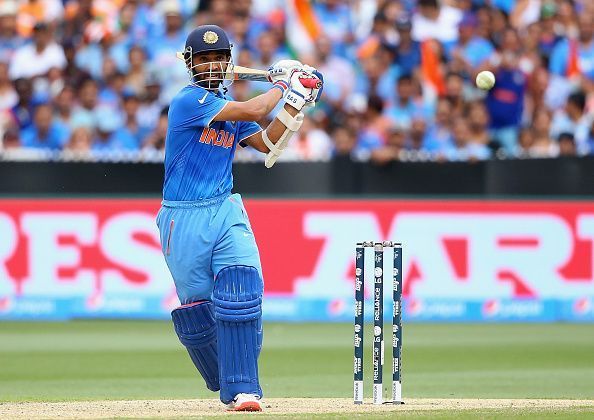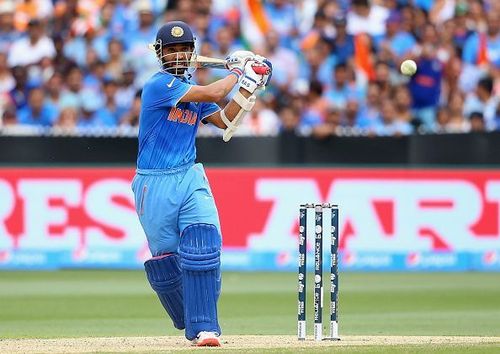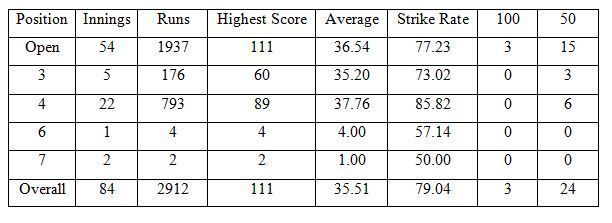
Deciphering Ajinkya Rahane's constantly changing roles in ODIs

Cricket, being a game which has a lot of variables affecting the decision making, sees its dynamics keep changing constantly. We often hear myriad terms such as horses for courses, current form, match-winner, conditions, bits and pieces cricketer when the team selections are discussed. No player is permanently assured of his place in the team and has to keep evolving to meet the demands of the game.
The roles of the players also keep changing with the change in the formats, conditions and also the presence or absence of the other members in the squad. One such player who has always been made to change his role (batting position) is Ajinkya Rahane. Starting his ODI career as an opener, Rahane has shuttled between opening and middle order roles on numerous occasions based on the presence of the regular openers.
Here is the look at the phases in Rahane’s ODI career according to the role assigned to him by the team management.
Phase 1: Opener (3 September 2011 to 19 January 2013)
After his splendid performances in the Emerging Players Tournament in Australia, Rahane was called up as a replacement for injured Virender Sehwag in the Indian ODI squad for the tour of England in 2011. He played two full series against England as an opener with mediocre success.
With the return of the regular openers, Rahane had to wait for his opportunities and played in the final inconsequential games in three series against West Indies, Sri Lanka and Pakistan, but, could not score big runs. He was given the chance to open the innings again when Virender Sehwag was dropped from the ODI squad against England in 2013. Rahane missed his opportunity and Mahendra Singh Dhoni dropped him for Rohit Sharma after the first three ODIs.

Phase 2: Middle-order batsman/ Reserve opener (3 August 2013 to 20 January 2016)
With Rohit Sharma and Shikhar Dhawan establishing themselves as the first choice opening pair post the Champions Trophy in 2013, Rahane batted at a No.3 and scored a fifty in the only match of the series he played against Zimbabwe, but, was not selected in the subsequent series with the return of the regulars.
He made a comeback as a middle order option during South Africa tour in 2013 and played at that position during the New Zealand series and the Asia Cup that followed. In most of the 2014 post the Asia Cup, Rahane was asked to open the innings due to the absence of the regular opener and he did admirably well scoring two centuries during the period. Further, during the extended run he got as an opener (England, Windies, Sri Lanka, Australia tri-series), the right-hander averaged 43.76 which is considerably high than his overall average.
Rahane played a special knock of 79 during the World Cup 2015 against South Africa at number four, but, did not have any other meaningful contribution. In the next series in Bangladesh, he was dropped after the first match for his inability to rotate strike on slow pitches.
With many first choice batsmen rested, he was appointed as the captain for the tour of Zimbabwe that followed. Returning to the opening slot in Zimbabwe, Rahane failed to register a big score and thereby, make a strong case to be considered an opener in the regular side. However, he was pretty consistent in the series against South Africa and Australia, scoring five fifties in eight innings in the middle order.

Position wise Record during Phase 2

Overall Record during Phase 2
Phase 3: Opener (16 October 2016 to 1 October 2017)
Rahane was again asked to open the innings during the New Zealand series in October 2016 as Shikhar Dhawan missed out due to an injury. This time the team management had defined the Mumbaikar as an opener and played him only when any regular opener missed out. Thus, he played just a single game against England and missed out on a berth in the playing XI for the Champions Trophy.
Replacing Rohit Sharma on the tour to Windies, Rahane was the Man of the Series with 336 runs in five matches at an average of 67.20. Yet, he could get a look-in in just a single game in the Sri Lanka series. Again, opening the innings in the absence of Dhawan against Australia, he came out with flying colours scoring four back-to-back half-centuries.
The rigid approach of the management meant that despite such consistent scores (eight 50+ scores in previous 11 innings), he had to miss out during the New Zealand and Sri Lanka series as numerous other players were tried at the number four spot.

Overall Record during Phase 3
Phase 4: Middle order (From 1 February 2018)
After Yuvraj Singh was dropped from the team post the Windies tour, the Indian team tried KL Rahul, Manish Pandey, Kedar Jadhav, Hardik Pandya, Dinesh Karthik and Shreyas Iyer for the middle order role.
None of the players could cement his position as the players did not get a long run at a particular spot. With a lot of overseas tours coming up, the management became flexible and opted for Rahane as the number four batsman. His technique and ability to bat well in the seaming and bouncing conditions was on display in the first ODI against South Africa where he compiled 79 runs in India’s easy win at Durban.

Rahane's Overall ODI Record

Rahane’s willingness to bat at any position as per the demands of the team management and patience to wait for his chances are stand-out qualities. Despite batting at different numbers, he averages in excess of 35 in all the positions from number one to number four.
Further, whenever he was given an extended run at a particular position (as an opener in 2014, in the middle order during South Africa and Australia series in 2015-16 and again as an opener during the series against West Indies and Australia in 2017), he came up with consistent performances. The only concerns with regard to his ODI batting are the strike rate and his inability to convert 50s into 100s. With lots of overseas tours following, Rahane should be given a long run in the middle order before trying the other contenders.